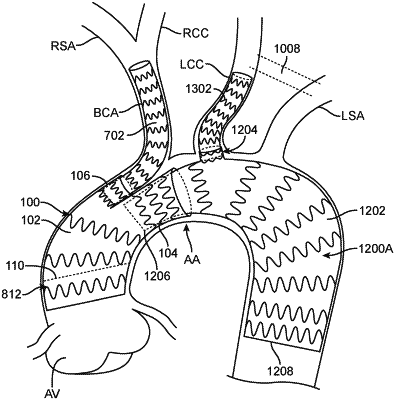| CPC A61F 2/90 (2013.01) [A61F 2/07 (2013.01); A61F 2/852 (2013.01); A61F 2/856 (2013.01); A61F 2/89 (2013.01); A61F 2/954 (2013.01); A61F 2002/061 (2013.01); A61F 2002/065 (2013.01)] | 12 Claims |

|
1. A method comprising:
deploying a first modular stent device in an ascending portion of an aorta, the first modular stent device including:
a first main body;
a first bypass gate extending from a distal end of the first main body; and
a first artery leg extending from a distal end of the first main body;
wherein the first main body has a first longitudinal axis through a center of the first main body, the first bypass gate has a second longitudinal axis through a center of the first bypass gate, and the first artery leg has a third longitudinal axis through a center of the first artery leg, the first, second, and third longitudinal axes are parallel with one another when the first modular stent device is in a relaxed configuration;
wherein the first artery leg is shorter than the first bypass gate;
wherein the first main body has a first diameter, the first bypass gate has a second diameter, and the first artery leg has a third diameter, the second diameter being greater than the third diameter;
wherein the first artery leg has a greater radial force than a radial force of the first bypass gate;
the first bypass gate and the first artery leg are deployed in the aorta and the greater radial force of the first artery leg causes the first bypass gate to collapse preferentially to the first artery leg;
deploying a first bridging stent graft within the first artery leg and extending into a brachiocephalic artery;
deploying a second modular stent device in the first bypass gate, the second modular stent device including:
a second main body;
a second bypass gate extending from a distal end of the second main body; and
a second artery leg extending from a distal end of the second main body;
wherein the second main body has a fourth longitudinal axis through a center of the second main body, the second bypass gate has a fifth longitudinal axis through a center of the second bypass gate, and the second artery leg has a sixth longitudinal axis through a center of the second artery leg, the fourth, fifth, and sixth longitudinal axes are parallel with one another when the second modular stent device is in a relaxed configuration;
wherein the second artery leg is shorter than the second bypass gate;
wherein the second main body has a fourth diameter, the second bypass gate has a fifth diameter, and the second artery leg has a sixth diameter, the fifth diameter being greater than the sixth diameter;
the second main body is deployed within the first bypass gate
the second bypass gate extends past a left subclavian artery and into a descending aorta; and
deploying a second bridging stent graft within the second artery leg and extending into a branch vessel selected from a left common carotid artery or the left subclavian artery, wherein the second bridging stent graft extends from a distal opening of the second artery leg that is located proximal to the branch vessel.
|